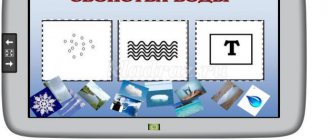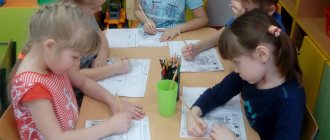Interactive technologies in kindergarten
Today, in order to keep up with the times and constantly improve their teaching skills, kindergarten teachers have to use a complex of various developmental techniques and all their imagination. Educational standards provide for the use of various types of children's activities that the teacher must use to solve pedagogical problems. The authoritarian pedagogical style is a thing of the past; preference is given to democratic interactive technologies, implying multilateral communication, effective methods and methods of close interpersonal interaction based on dialogue, cooperation, and mutual understanding.
Interactive technologies are a set of pedagogical methods aimed at building the educational process in conditions of effective interaction.
Interactive technologies can be expressed in various forms:
- Individual (the child, with the help of the teacher, solves the problem himself, option – “child - computer”),
- Steam room (child-child interaction),
- Group (work in subgroups),
- Collective (active frontal work),
- Planetary (solving assigned problems by subgroups and choosing the optimal option).
Advantages of interactive technologies:
- Preschoolers develop individual personal conditions for self-development;
- Speech activity develops;
- Interpersonal relationships develop;
- Skills of playing in a team based on moral standards are developed;
- Children become aware of their personal intellectual worth;
- The psychology of success is being formed.
The implementation of interactive technologies in preschool educational institutions is possible subject to the conditions of comfortable cooperation between the teacher and preschoolers, motivation in solving the task, and the use of vivid images, examples, and objects.
Particular attention in the pedagogical process is paid to creating a comfortable creative environment and awareness of the intellectual competence of students. In an atmosphere of goodwill and support, within the framework of close interaction, free communication on equal terms, the preschooler feels personal success and the learning process becomes more productive. Interactive technologies are designed to make the learning process not just interconnected, but also more exciting and creative.
The introduction of interactive technologies in kindergarten is carried out in stages, taking into account age characteristics, for example:
- Younger age group: play in pairs, “children’s circle”,
- Middle age group: game in pairs, round dance, carousel, chain;
- Older age group: work in pairs, “children’s circle”, carousel, chain, interview, lesson in small groups (threes), aquarium;
- Preparatory (pre-school) group: lesson in pairs, “children’s circle”, chain, carousel, interview, lesson in small groups, large children’s circle, tree of knowledge.
It is worth noting that the teacher, based on his experience, can experiment with forms of interaction, and, for example, introduce interviews in the middle group.
interactive methods help stimulate the diversified development of a preschooler . This concept consists of two components: “method”, as a way of interaction between “teacher and child” and “interaction” – intensive activity between participants in the process. Accordingly, interactive methods mean enhanced pedagogical interaction during the educational process.
Interactive methods can be discussion, game, complex:
- Role-playing game (theater production, fairy tale),
- Interactive game
- Business game,
- Case method (solving a problem situation),
- Discussion,
- Clusters (search for associations),
- Microphone (alternate statements),
- Debate (discussion of statements),
- Project method
- Brainstorming and others.
Examples of the use of interactive methods in different age groups of preschool educational institutions
Junior or II junior group: interactive method of working in pairs.
The teacher invites the children to find a partner or helps them break up in pairs, hold hands and look at each other. This can be done while sitting on the floor, on chairs, or standing. As a rule, at this age children already know each other's names. Each pair is asked to hold a toy, cube, or ball together. The teacher can hand over a bright object to each pair. He announces to the children that these toys are magical; whoever holds it in their hands smiles. When passing a toy to each other, you need to call your partner by name and smile. At the same time, the teacher himself must radiate affection and a smile and demonstrate action. Children are prone to imitations, they will repeat. Teaching practice will be successful if most of the children smile. Further, the teacher can complicate the rules: children change pairs, toys, give compliments, etc.
Middle group: interactive chain game. The teacher prepares a toy in advance - Luntik and tells the backstory: Luntik flew from the Moon, he knows Kuzya, Shershulya, Vupsen and Pupsen... the children help list the heroes of the fairy tale. Next, the task is set: besides the listed heroes, Luntik knows no one, he is not familiar with animals from fairy tales, he needs to be introduced. The teacher hands the Luntik figurine to one of the children and asks them to pass it further down the chain and name animals from different fairy tales, for example, a wolf from the fairy tale “The Wolf and the Seven Little Kids”, a bear from the fairy tale “Masha and the Bear”, “The Three Little Pigs”, “Puss in Boots” " and so on. Passing Luntik to each other, children introduce him to fairy-tale characters. If a preschooler is lost, then the teacher and the children on the left and right of the chain help remember fairy tales. In conclusion, the teacher can invite the children to fantasize about Luntik’s adventures in the land of fairy tales or to draw fairy-tale animals.
Senior preparatory group: comprehensive interactive lesson “My favorite kindergarten.” The teacher sets a task: the children need to prepare a presentation about what they like most about the kindergarten. Children are seated at tables in small groups of 3-4 people, with drawing kits on the tables. The teacher invites one group to discuss the topic of which toys are the most interesting in the group, the second group - which dish in the kindergarten is the most delicious, the third group - what interesting things can be seen during a walk, the fourth group - what they like most in a music lesson, and so on. Children in small groups discuss their options, draw on sheets of paper, and choose a representative from the group. The teacher approaches each group, helps with choices and resolves disputes. Next, representatives from each group take turns going to an improvised microphone and voice what exactly they like about the kindergarten, demonstrating the best drawing or several drawings from the group. The teacher, summing up, during a frontal discussion, based on the most interesting moments, composes a story about his favorite kindergarten, summarizes the information he heard, or offers to make a single presentation for children who want to speak at the microphone. You can place the pictures as visual cues and invite the children to write the story “My Favorite Kindergarten.”
Options for additional and main discussion topics: “The kindergarten of my dreams,” “My favorite activity in the kindergarten,” “Choice of a fairy tale for the children’s theater,” “The best gift for mom,” “Decorating the kindergarten,” etc.
Interactive pedagogical technologies are directly related to the use of interactive technical means. More and more children's institutions have high-tech equipment in the form of sensory boards, educational gaming computers, and interactive panels. Their use helps make the educational process more fun, interesting, and productive.
With the use of interactive technologies, the roles of the teacher and children change. The teacher's initiative decreases, the children's activity increases. Pedagogical skill lies in the ability to create comfortable psychological and practical conditions for the creative development of children, to overcome the threshold of shyness of some categories of pupils, for productive interaction and the success of the educational process.
If you found the information on the site useful, please share it on social networks:
Related posts:
Interactive methods of teaching and interacting with children
Interactive teaching methods are ways of targeted interaction between adults and children that provide optimal conditions for their development.
Interactive learning for preschoolers is a specific form of organizing educational activities, the purpose of which is to provide comfortable conditions for interaction in which each child feels his success and, by performing certain intellectual work, achieves high productivity.
Interactive teaching methods provide such learning that enables children in pairs, microgroups or small groups to work through educational material, talking, arguing and discussing different points of view.
Activity in pairs
- Find a couple and share
After the sharing and discussion described in the first idea above, you can also ask students to find a new partner and share with them the learnings and realizations that occurred in a previous partnership with another student.
- Teacher and pupil
Invite students to discuss the main points of the lesson. Then divide students into pairs and assign them 2 roles. One of them is a teacher, and the other is a student. The teacher's job is to jot down the main points, while the student's job is to cross off items on his list as they are mentioned and come up with 2-3 items that the teacher missed.
- Share your partner's results
After individual creative activity, pair students to share their results. Then give the floor to volunteers who found their partner's work interesting or exemplary. Students are often more willing to publicly share fellow students' work than their own. As a result, you can gently lead them to share their findings and perhaps even the results of their work.
- Forced dispute
Have students discuss in pairs. They must defend the opposite side of their personal opinion. This encourages students to step away from their own beliefs and teaches them to look at a situation from a different angle from time to time.
There may be this option: one half of the group takes one position, the other half another. Each person can speak only once so that all students on both sides can speak about the issue.
- Optimist/pessimist
In pairs, students consider opposing emotional sides of a case study, statement, or topic. Ask them to truly “live” the case study. You'll discover some good ideas and your students will gain important social skills.
- Expert review
To help students with a writing task, have them exchange drafts with a partner. The partner reads the essay and writes a 3-paragraph response: the first paragraph describes the strengths of the essay, the second paragraph discusses its problems, and the third paragraph describes what the partner would focus on in editing if it were their essay. Students can learn a lot from each other!
Other interactive teaching methods
In addition to the above-mentioned interactive methods of teaching preschoolers, the following are actively used in practice: creative tasks, work in small groups, educational games (role-playing and business games, simulation games, competition games (senior preschool age), intellectual warm-ups, work with visual videos and audio materials, thematic dialogues, analysis of life situations and the like.
Thus, interactive learning in classes (including integrated ones) takes place: in pairs (2 children), in microgroups (3-4 children), in small groups (5-6 children) together with the teacher.
When evaluating children’s statements, you should not use the word “correct”, but say: “interesting”, “unusual”, “good”, “wonderful”, “original”, which stimulates children to make further statements.
Worth remembering! When a preschool child sits politely on a chair, looks at you and just listens, he is not learning.
Individual training events
- Survey
It is best to use a survey at the end of the lesson. Ask students to write an answer to a specific question within one minute. For example: “What is the most important thing you learned today?”
Then you can start the conversation from there in the next lesson. You can ask students if they still remember what they wrote down.
- Checking for misconception
Identify student misconceptions. See if they can identify the correct answer when given a false fact. This is useful for reinforcing the previous lesson and also encourages students to think deeply and retain the material better.
- Circle the question
Create a checklist or survey with a list of questions (make them specific) about your topic and ask students to circle (or mark) the ones they don't know the answer to.
Create assignments based on the different questions that have been circled. Have your students work on additional exercises and explanations for these assignments individually. Since your students will all circle different questions, you should give each of them their own individual set of tasks.
OPEN AN ONLINE SCHOOL ON THE ANTI-TRAINING PLATFORM
- Ask the "A" student
Ask students to silently solve a problem or answer a question. After receiving an answer, ask those who did it correctly to raise their hands (if the lesson is taking place offline) or write about it in the chat (if you are teaching an online lesson). Then all other students should talk to someone who completed the task in order to better understand the essence and avoid making mistakes next time.
Insufficient use of interactive methods
Unfortunately, interactive teaching methods are not yet used enough in working with preschoolers. There are some reasons for this (according to A. Kononko):
- the habit of many educators to use explanatory, illustrative, monological methods in their work, to show conformism, to unquestioningly obey the requirements and principles of others;
- distrust of a certain part of teachers towards innovative dialogue methods and their fears;
- lack of experience in their effective use, active self-determination, making responsible decisions, providing advantages to someone (something);
- fear of looking like a “black sheep” in the eyes of others, funny, helpless, inept;
- low self-esteem, excessive anxiety of teachers;
- tendency to be overly critical;
- inability to quickly switch and adapt to new conditions and requirements;
- lack of formation of pedagogical reflection, the ability to objectively evaluate oneself, to correlate one’s capabilities and desires with the requirements of the time.
The need to introduce interactive methods into the educational process is obvious, because:
- today, more than ever, the requirements for updating preschool education for pupils are increasing;
- differentiation and individualization of education for preschool children occurs;
- The requirements for the quality of preschool education are changing, its assessment is not only based on the level of knowledge readiness, but also the elementary life competence of preschool educational institution graduates, their ability to apply knowledge in their own lives, constantly update and enrich it.



